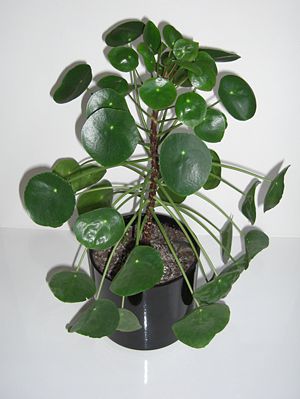Pilea peperomioides
| Pilea peperomioides | ||||||||||||
|---|---|---|---|---|---|---|---|---|---|---|---|---|

Pilea peperomioides |
||||||||||||
| Systematics | ||||||||||||
|
||||||||||||
| Scientific name | ||||||||||||
| Pilea peperomioides | ||||||||||||
| Diels |

Pilea peperomioides , also known in German-speaking countries under the names Glückstaler , Chinese money tree , UFO plant , missionary plant and belly button plant , is a species of plant from the genus cannon flowers ( Pilea ) in the nettle family(Urticaceae)native to Southeast Asia.
history
In 1906 George Forrest collected specimens of the plant in China. It was described by Ludwig Diels in 1912 . The plant came to Europe in 1946 through the Norwegian missionary Agnar Espegren. Due to the similarity of its leaves to those of some species of peperomioides , Pilea peperomioides was initially suspected of belonging to this genus, and after the assignment of the species to the cannon flowers, it was therefore given the name peperomioides . The assignment was made by examining the male flowers, which were not immediately available to the investigating botanists, which made assignment difficult. The plant was awarded the Award of Garden Merit by the Royal Horticultural Society in 1993 because of its modesty .
features
Pilea peperomioides is a perennial herbaceous plant . The stem axis is greenish to dark brown, mostly simple, often straight upright, somewhat woody at the base. If the growth conditions are poor, the plants lose their leaves in the lower area of the stem axis and thereby adopt a very distinctive habit . The plants are completely hairless. Their large, circular (taler-shaped), shiny, alternate leaves , which can be over 15 centimeters in diameter, are striking . The leaf stalks grow in the wild 2 to 17 centimeters long, in house plants up to 30 centimeters. The flowers are inconspicuous, with the same plant producing male and female flowers, but the female flowers less frequently.
distribution
This species is found only in China : in the southwest of Sichuan Province and in the west of Yunnan Province . Here it grows on shady, damp rocks in forests at altitudes of 1500 to 3000 m. It is very rare and its wild occurrence may be endangered. However, it is in China and around the world as an ornamental plant kept where they largely through offshoot vegetatively is increased.
use
Pilea peperomioides is used as a houseplant . Despite its beautiful shape, easy care and rapid growth, the plant is rarely found in stores. It forms fast-growing runners that are often passed on as a plant that brings luck ("lucky thaler") or friendship plant. Since constant temperatures and high humidity have a positive effect on plant growth, this type of plant is suitable for the greening of terrariums .
Individual evidence
- Entry in the "Flora of China" on efloras.org
- A. Radcliffe-Smith: Pilea peperomioides . Kew Magazine, Volume 1, 1984, pp. 14-19.
Web links
- Info and pictures. (English)
- "A Chinese puzzle solved - Pilea peperomioides" (English)
Individual evidence
- ↑ a b A Chinese puzzle solved - Pilea peperomioides. Retrieved August 23, 2018 .
- ↑ Details about the plant , loaded on October 16, 2018